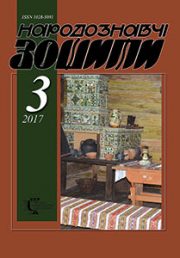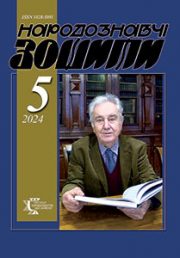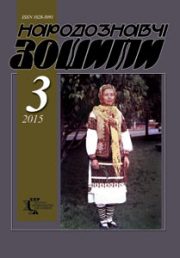The Ethnology Notebooks. 2020. № 1 (151), 165—176
UDK75.049:728]:75.071.1(477)Дяченко](045)
DOI https://doi.org/10.15407/nz2020.01.165
ARCHITECTURAL SKETCHES BY MYKHAYLO DYACHENKO
SHCHERBAN Anatoliy
ORCID ID: https://orcid.org/0000-0002-9530-6453
Doctor of Science in Culturology,
Ph.D. in History,
head of department of history, museology
and heritage study,Kharkiv State Academy of Culture,
4, Lowering of bursa, 61057, Kharkiv, Ukraine,
Contacts: e-mail: kozaks_1978@ukr.net
KOTLYAR Yevgen
ORCID ID: https://orcid.org/0000-0001-7698-418X
Ph.D. in Art History, Associated Professor,
Professor at the Department of Monumental Painting,
Kharkiv State Academy of Design and Art,
8, Str. of Arts, 61000, Kharkiv, Ukraine,
Contacts: e-mail: eugeny.kotlyar@gmail.com
Abstract. Summary: Introduction. The article is devoted to scientific and artistic heritage of Mykhaylo Dyachenko, an Ukrainian artist, publicist, ethnographer and educator who worked productively in these areas during 1909—1931. His biography, artistic and scientific achievements have only begun to be analyzed in recent years.
Problem Statement. In this article, for the first time, drawings of architectural structures made by a research artist during 1926—1928 in Cherkasy and Chernihiv districts are described. The names of all currently known images are listed. Attention is drawn to sketches of the synagogue in Cherkasy, Ukrainian folk and palace architecture of Pryluchyna, Chernihiv district.
Conclusion. The conclusion is made about important role of Danylo Shcherbakivsky in the implementation of analyzed activity by Mykhaylo Dyachenko. Mykhaylo Dyachenko’s place among Ukrainian architecture researchers is outlined. In particular, thanks to the drawings of the synagogue in Cherkasy, their author’s name was put in parallel with other Ukrainian scholars and museum workers of the 1920s—1930s, whose efforts formed a scientific base for monuments of Jewish material culture in Ukraine that were soon destroyed. Architectural sketches were made by Dyachenko in Pryluchyna as a result of field studies, during which the most outstanding samples of palace construction were recorded, as well as the most typical, characteristic and original samples of Ukrainian ethnic building in its general forms and individual details. So, he is considered to be one of the leading researchers in this field. Mykhaylo Dyachenko’s artistic heritage was analyzed against the background of biographical data explaining the reasons for interest in these regions.
Keywords: Mykhaylo Dyachenko, Danyla Shcherbakivsky, synagogue in Cherkasy, Pryluchyna, drawings.
Received 6.01.2020
REFERENCES
Architecture. Podillya. (1926). T. Slavuta. Drawings of ink and watercolor art. Gvozdetsky, 1926. Scientific Archives of the Institute of Archeology of the National Academy of Sciences of Ukraine. F. 9 (Danylo Mikhailovich Shcherbakivskyi Author’s Found (1877—1927). Spr. 42 [in Ukrainian].
Bochkov, D. (1929). Curriculum vitae Dyachenko, Mikhaylo Mikhailovych, freelance officer of the Cherkasy Okrmuzeum. It is life histories of archeology and art researchers. Scientific Archives of the Institute of Archeology of the National Academy of Sciences of Ukraine. F. VUAK. Spr. 32 [in Ukrainian].
Open letter 187. Scientific Archives of the Institute of Archeology of the National Academy of Sciences of Ukraine. F. VUAK. Spr. 32. № 202/17 [in Ukrainian].
Open letter 188. Scientific Archives of the Institute of Archeology of the National Academy of Sciences of Ukraine. F. VUAK. Spr. 32. № 202/17 [in Ukrainian].
Dyachenko, D. (1927). Drawing monuments of art in Cherkasy region. Briefing of VUAC, 1926. Kyiv [in Ukrainian].
Dyachenko, M. House in Digtyari. 1928. Paper, watercolors. 27,2 x 34,9 cm. Funds of the National Art Museum of Ukraine, Grs-9877 [in Ukrainian].
Dyachenko, M. To Upnauka. Scientific Archives of the Institute of Archeology of the National Academy of Sciences of Ukraine. F. 9. Spr. 46 [in Ukrainian].
Dyachenko, M. Drawing of monuments of art in the Pryluchyn. Autograph. Scientific Archives of the Institute of Archeology of the National Academy of Sciences of Ukraine. F. 9. Spr. 46 [in Ukrainian].
Dyachenko, M. Drawing of monuments of art in the Pryluky Region. Drawings with pencil and ink. Scientific Archives of the Institute of Archeology of the National Academy of Sciences of Ukraine. F. 9. Spr. 46 [in Ukrainian].
Dyachenko, M. Statement to the Prylutska Narosvita of April 2, 1927. State archive of Chernihiv region. F. R-5492. Op. 1. Spr. 1223. Arc. 112 [in Ukrainian].
Dyachenko, M. Synagogue in Cherkasy on the Jewish Street, 12, 1850. General view. 1926. Paper, pencil. 15 x 19 cm; Side view. 1926. Paper, pencil. 15 x 19 cm. V.G. Zabolotnyi State Scientific Architectural and Construction Library. 72 (084.94). Г 14719/1, Г 14719/2 [in Ukrainian].
Kanevsky, Y. (1928, march). Year of work of the Pryluky Museum. Bulletin of the Pryluky District Museum, 1, 4—9 [in Ukrainian].
Kotlyar, E.A. (2009). Jewish museums and collections of the first third of the XX century: fate and traces of artistic heritage (Lviv — St. Petersburg — Odessa — Kyiv). Bulletin of the Kharkiv State Academy of Design and Arts, 12, 113—133 (Oriental Studies. Issue 2). Kharkiv: KhDADM [in Russian].
Kotlyar, E. (2012). Paintings of wooden synagogues of the Dnieper: problems and prospects of research. Bulletin of Kharkiv State Academy of Design and Arts, 13, 91—100. Kharkiv: KhDADM [in Russian].
Kotlyar, E., & Solodova, V. (Ed.). (2016). Usher Heather and Elukim Maltz: in search of lost expeditions of the Jewish Museum in Odessa. Bulletin of the Odessa Museum of Local History. Scientific Collection: Proceedings of the 5th International Scientific and Practical Conference «Museum. History. Odessa», dedicated to the 60th anniversary of the Odessa Museum of History and Local History, 15, 175—185. Odessa: Astroprint [in Russian].
Kotlyar, E. (2014). Danylo Shcherbakivskyi: Scientific Intelligence and Discoveries of Jewish Art. The Ethnology notebooks, 5 (119), 896—910. Lviv: Institute of Ethnology; NAS of Ukraine [in Ukrainian].
Letter from M. Dyachenko to F. Ernst dated June 14, 1927. Archive of the Institute of Art Studies, Folklore and Ethnology named after M.T. Rylsky. F. 13-3. Arc. 38—39 [in Ukrainian].
Lukomsky, G.K. (1913). Volyn antiquity: a description of the monuments of ancient architecture. Art in southern Russia, 7—8, 285—343 [in Russian].
Lukomsky, G.K. (1915). Galicia in its antiquity: essays on the history of architecture of the XII—XVIII centuries. and drawings by G.K. Lukomsky. Petrograd: Publishing. T-va R. Golike and A. Vilborg [in Russian].
Lukomsky, G.K. (1917). Ancient estates of the Kharkov province. Published in favor of a burnt church in a. Lyutovke (Part 1). Petrograd: Edition of Count N.V. Kleinmichel, T.R. Golike and A. Wilborg [in Russian].7
Nestulia, O.O. (1995). The Fate of Church Antiquity in Ukraine. 1917—1941 (Part 1: 1917 — mid 20’s.). Kyiv: Institute of History of Ukraine of NASU [in Ukrainian].
Nestulia, O.O. (1995). The Fate of Church Antiquity in Ukraine. 1917—1941(Part 2: End of the 20’s — 1941). Kyiv: Institute of History of Ukraine of NASU [in Ukrainian].
Novitsky, O. (1927). Activities of the Artistic Department of the Archaeological Committee. 1926 brief of the VUAC (Pp. 175—176). Kyiv [in Ukrainian].
Plamenitskaya, O. (1996). Some features of architecture of Podolsk cities and towns based on the materials of Mykola Toporkov’s collection. Architectural heritage of Ukraine (Issue 3, part 2, pp. 189—198). Kyiv: Ukrainian Studies [in Ukrainian].
The plan of the existing two-light wooden Jewish prayer synagogue located on the Jewish street of the 1st police station in the city of Cherkasy in the Kyiv province […]. State Archive of Kyiv Oblast. F. 1. Op. 235. Spr. 101. Ark. 9b [in Ukrainian].
Selivachov, M.R. (2009). Lexicon of Ukrainian ornamentation (iconography, nomination, stylistics, typology). 2nd species. Kyiv: Editorial of the Ant Bulletin [in Ukrainian].
Teka M. Toporkova. V.G. Zabolotnyi State Scientific Architectural and Construction Library, 72 (084.94), Г 7815—8033; 5588—5597 [in Ukrainian].
M.P. Toporkov Found. The Ukrainian SSR. Folk architecture: dimensions, plans, sketches of nature, interiors, details. A.V. Shchusev State Museum of Architecture, Moscow, PV 1104—1146 [in Russian].
Khodak, I. (2010). Scientific activity of Danylo Shcherbakivskyi in the context of the history of Ukrainian art criticism of the first third of the XX century. The thesis for the academic degree of Doctor of Arts. Kyiv: IMFE [in Ukrainian].
Khodak, I.O. (2017). Natalya Kotsyubynska and the Cabinet of Ukrainian Art of the All-Ukrainian Academy of Sciences (from the history of national art criticism in the 1920s — early 1930s). (Pp. 60—139). Kyiv: IMF them. M.T. Rylsky; Kharkiv: Publisher Alexander Savchuk [in Ukrainian].
Cherkasy district «Customs» with a synagogue during the great story of 1888. Photo. Cherkasy Regional Museum of Local History, Fn-3 (1) [in Ukrainian].
Shcherbakivsky, D (1927). Monuments of art on the Right Bank. Brief statement of the All-Ukrainian Archeological Committee for 1926 (Pp. 191—209). Kyiv: UA; VUAC [in Ukrainian].
Shcherban, A. (2018). Pottery of the village of Tsvitne according to the research of Mykhailo Dyachenko in 1928. Folk creativity and ethnology, 5, 113—118 [in Ukrainian].
Shcherban, A.L. (2017). Mikhaylo Dyachenko is an unknown monument historian of the 1920s and early 1930s. Sixth Zaremba Readings (Pp. 68—71). Kyiv: Tsentr pamiatkoznavstva NAN Ukrainy i UTOPIK [in Ukrainian].
Hubka, T. (1998). Jewish Art and Architecture in the East European Context: The Gwozdziec — Chodorow Group of Wooden Synagogues (Vol. 10, pp. 141—182). Polin. Oxford.
Piechotka, M. and K. Heaven’s Gate. (1996). Wooden synagogues in the lands of the former Polish-Lithuanian Commonwealth. Warsaw: Widawnictwo Krupski, S-ka [in Polish].







